
John Lawrence LeConte was an American entomologist, responsible for naming and describing approximately half of the insect taxa known in the United States during his lifetime, including some 5,000 species of beetles. He was recognized as the foremost authority on North American beetles during his career, and has been described as "the father of American beetle study".

Amphizoa is a genus of aquatic beetles in the suborder Adephaga, placed in its own monogeneric family, Amphizoidae. There are five known species of Amphizoa, three in western North America and two in the eastern Palearctic. They are sometimes referred to by the common name troutstream beetles.

Agathidium is a genus of beetles in the family Leiodidae.
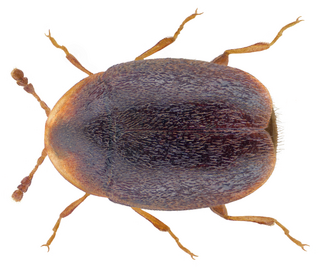
Corylophidae is a family of minute hooded beetles, sometimes called minute fungus beetles, in the superfamily Coccinelloidea. There are about 18 genera and at least 120 described species in Corylophidae. They feed on microfungi such as molds, and are often found associated with bark, as well as in leaf litter and other decaying vegetation. In older literature, the family name was often given as Orthoperidae.

Eleodes is a genus of darkling beetles, in the family Tenebrionidae. They are endemic to western North America ranging from southern Canada to Mexico with many species found in the Sonoran Desert and Southern California. Some species have been introduced to Colombia. The name pinacate is Mexican Spanish, derived from the Nahuatl (Aztec) name for the insect, pinacatl, which translates as "black beetle."
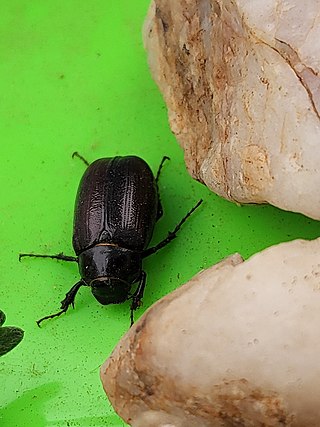
Diplotaxis is a large genus of scarab beetles in the subfamily Melolonthinae. There are at least 250 described species in the genus Diplotaxis distributed over North and Central America.

The Brachypsectridae are a family of beetles commonly known as the Texas beetles. There are only two extant genera, Brachypsectra and Asiopsectra. Brachypsectra has a cosmopolitan distribution, mostly in arid regions, while Asiopsectra is found in Central Asia and the Middle East.
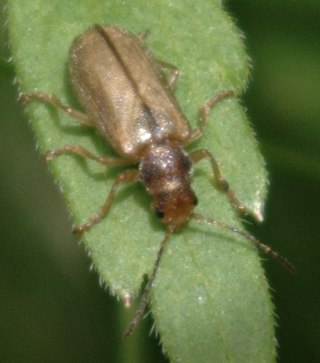
Syneta is a genus of leaf beetles in the subfamily Synetinae. There are about 11 described species in Syneta. The genus is entirely holarctic in distribution, with species appearing in North America, Siberia, East Asia and Northern Europe.

Trachyderini is a tribe of long-horned beetles in the family Cerambycidae. There are at least 140 genera and 650 described species in Trachyderini.
Cnesinus elegans is a species of beetles in the family Scolytinae. It is found in Mexico.
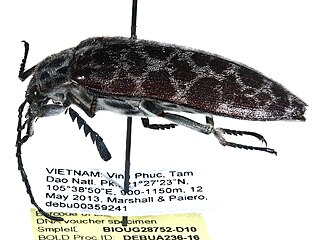
Eulichadidae is a family of beetles belonging to Elateriformia. There are two extant genera, Eulichas with several dozen species native to the Indomalayan realm of Asia, and Stenocolus, with a single species native to Western North America. The larvae are aquatic, with the larvae of Eulichas being found in sandy sediments of clean forest streams, while the larvae of Stenocolus are found under rocks and in leaf packs in low elevation streams and rivers. They are herbivious/saprophagous with larval specimens of Eulichas having been found with wood particles in their stomachs, while the larvae of Stenocolus are known to feed on decaying roots and detritus. The adults are terrestrial, with specimens of Eulichas typically found using light, while specimens of Stenocolus are typically found in riparian vegetation, and are not attracted to light. Potential extinct genera have been described from Mesozoic rocks, but the placement of several of these taxa in the family is disputed.

Limnichidae, commonly called minute marsh-loving beetles, is a family of beetles belonging to Byrrhoidea. There are at least 30 genera and 350 described species in Limnichidae. They are found worldwide, with the greatest diversity in tropical regions. Most species seem to be associated with water-adjacent habitats, such as riparian and coastal locations, though many species are likely fully terrestrial, with some species being associated with leaf litter and arboreal habitats. Species with known diets feed on moss or algae. The oldest fossils of the family are known from mid-Cretaceous Burmese amber from Myanmar.

Rhipiceridae is a family of beetles found worldwide. The larva of rhipicerids are parasitoids of cicada nymphs. Rhipiceridae and Dascillidae form the super family Dascilloidea, within the Elateriformia.
Hydnobius is a genus of round fungus beetles in the family Leiodidae. There are about seven described species in Hydnobius.
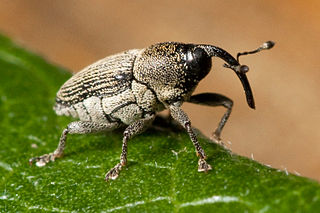
Apostasimerini is a tribe of flower weevils in the family of beetles known as Curculionidae. There are over 240 genera and nearly 1700 described species in Apostasimerini.
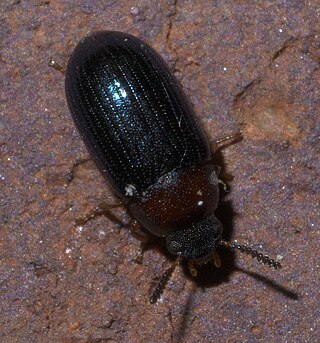
Hylesinini is a tribe of crenulate bark beetles in the family Curculionidae. There are at least 20 genera and 80 described species in Hylesinini.
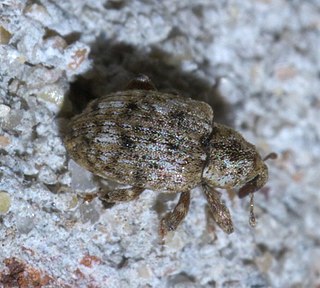
Conotrachelini is a tribe of true weevils in the family of beetles known as Curculionidae. There are about 7 genera and at least 50 described species in Conotrachelini.
Barilepton is a genus of flower weevils in the beetle family Curculionidae. There are about 13 described species in Barilepton.
Graphops is a genus of leaf beetles in the subfamily Eumolpinae. There are 19 described species in Graphops, all from North America. Most species have limited flight capabilities, due to poorly developed wings, and at least one species is known to be flightless.
Monoxia is a genus of skeletonizing leaf beetles in the family Chrysomelidae. There are about 18 described species in Monoxia. They are found in North America and the Neotropics.















